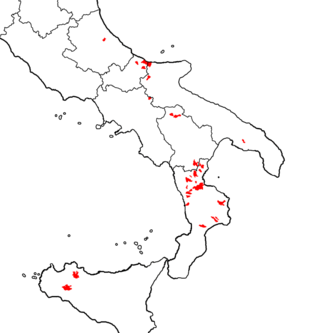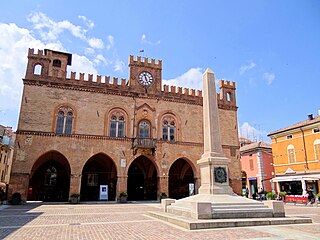
Sicilian cuisine is the style of cooking on the island of Sicily. It shows traces of all cultures that have existed on the island of Sicily over the last two millennia. Although its cuisine has much in common with Italian cuisine, Sicilian food also has Greek, Spanish, French, Jewish, and Arab influences.

In the arts and in literature, the term avant-garde identifies a genre of art, an experimental work of art, and the experimental artist who created the work of art, which usually is aesthetically innovative, whilst initially being ideologically unacceptable to the artistic establishment of the time. The military metaphor of an advance guard identifies the artists and writers whose innovations in style, form, and subject-matter challenge the artistic and aesthetic validity of the established forms of art and the literary traditions of their time; thus how the artists who created the anti-novel and Surrealism were ahead of their times.

Nalanda was a renowned mahavihara in ancient Magadha, eastern India. Considered by historians to be the world's first residential university and among the greatest centers of learning in the ancient world, it was located near the city of Rajagriha and about 90 kilometres (56 mi) southeast of Pataliputra. Operating from 427 until 1197 CE, Nalanda played a vital role in promoting the patronage of arts and academics during the 5th and 6th century CE, a period that has since been described as the "Golden Age of India" by scholars. Before it was destroyed and burned much of its facilities at the beginning of the twelfth century by the Islamic invader Bakhtiyar Khilji, Nalanda held over 9 million texts.

The Arbëreshë, also known as Albanians of Italy or Italo-Albanians, are an Albanian ethnolinguistic group in Southern Italy, mostly concentrated in scattered villages in the region of Calabria and, to a lesser extent, in the regions of Abruzzo, Apulia, Basilicata, Campania, Molise and Sicily. They are the descendants of Albanian refugees who fled Albania, and later some from Morea between the 14th and the 18th centuries following the Ottoman conquest of the Balkans.

The Battle of Saint-Quentin of 1557, was a decisive engagement of the Italian War of 1551–1559 between the Kingdom of France and the Spanish Empire, at Saint-Quentin in Picardy. A Habsburg Spanish force under Duke Emmanuel Philibert of Savoy defeated a French army under the command of Louis Gonzaga, Duke of Nevers, and Anne de Montmorency, Duke of Montmorency.

Joachim of Fiore, also known as Joachim of Flora and in Italian Gioacchino da Fiore, was an Italian Christian theologian, Catholic abbot, and the founder of the monastic order of San Giovanni in Fiore. According to theologian Bernard McGinn, "Joachim of Fiore is the most important apocalyptic thinker of the whole medieval period." The Divine Comedy of Dante Alighieri is one of the most famous works possibly inspired by his ideas.

San Lazzaro degli Armeni is a small island in the Venetian Lagoon which has been home to the monastery of the Mekhitarists, an Armenian Catholic congregation, since 1717. It is one of the two primary centers of the congregation, along with the Mekhitarist Monastery of Vienna.

Fidenza is a town and comune in the province of Parma, Emilia-Romagna region, Italy. It has around 27,000 inhabitants. The town was renamed Fidenza in 1927, recalling its Roman name of Fidentia; before, it was called Borgo San Donnino.

A matha, also written as math, muth, mutth, mutt, or mut, is a Sanskrit word that means 'institute or college', and it also refers to a monastery in Hinduism. An alternative term for such a monastery is adheenam. The earliest epigraphical evidence for mathas related to Hindu-temples comes from the 7th to 10th century CE.

Orbetello is a town and comune in the province of Grosseto (Tuscany), Italy. It is located about 35 kilometres (22 mi) south of Grosseto, on the eponymous lagoon, which is home to an important Natural Reserve.

Capestrano is a comune and small town with 885 inhabitants (2017), in the Province of L'Aquila, Abruzzo, Italy. It is located in the Gran Sasso e Monti della Laga National Park.
San Pietro Avellana is a comune (municipality) in the Province of Isernia in the Italian region of Molise, about 50 kilometres (31 mi) northwest of Campobasso and some 20 kilometres (12 mi) north of Isernia. As of 31 December 2004, it had a population of 630 and an area of 45.0 square kilometres (17.4 sq mi).

San Leucio is a frazione of the comune of Caserta, in the region of Campania in southern Italy. It is most notable for a resort developed around an old silk factory, named a UNESCO World Heritage Site in 1997.

The Roman Catholic Diocese of Fidenza in the Province of Parma, Italy, was until 1927 named the Diocese of Borgo San Donnino. It is now a suffragan of the Metropolitan Archdiocese of Modena-Nonantola, though historically it was long subject to the Archdiocese of Bologna.

A variety of ancient higher-learning institutions were developed in many cultures to provide institutional frameworks for scholarly activities. These ancient centres were sponsored and overseen by courts; by religious institutions, which sponsored cathedral schools, monastic schools, and madrasas; by scientific institutions, such as museums, hospitals, and observatories; and by respective scholars. They are to be distinguished from the Western-style university, an autonomous organization of scholars that originated in medieval Europe and has been adopted in other regions in modern times.
Francesco Antonio Santori was an Italian writer, poet and playwright of Arbëreshë descent. His play Emira is considered to be the first original Albanian drama ever written. The main character is a young and innocent girl who becomes a victim. Albanian literature of that time does not present many female characters like Ermira.

Arakelots Monastery was an Armenian monastery in the historic province of Taron, 11 km south-east of Mush (Muş), in present-day eastern Turkey. According to tradition, Gregory the Illuminator founded the monastery to house relics of several apostles. The monastery was, however, most likely built in the 11th century. During the 12th-13th centuries it was a major center of learning. In the following centuries it was expanded, destroyed and renovated. It remained one of the prominent monasteries of Turkish (Western) Armenia until the Armenian genocide of 1915, when it was attacked and subsequently abandoned. It remained standing until the 1960s when it was reportedly blown up. Today, ruins of the monastery are still visible.

Ken Albala is Tully Knoles Endowed Professor of History at the University of the Pacific. He has authored or edited 27 books on food and co-authored "The Lost Art of Real Cooking" and "The Lost Arts of Hearth and Home." Albala co-edited the journal "Food, Culture and Society" and has made numerous appearances in media and at conferences discussing food issues He is featured on the DVD: "Food: A Cultural Culinary History." and "Cooking Across the Ages." Albala is also known for his "Food Cultures Around the World" series for Greenwood Press and Rowman and Littlefield Studies in Food and Gastronomy.
The following is a timeline of the history of the city of Ferrara in the Emilia-Romagna region of Italy.

Santa Maria delle Grazie, also known as Madonna del Letto, is a Renaissance-style, Roman Catholic church located near the city center in Pistoia, region of Tuscany, Italy.


















